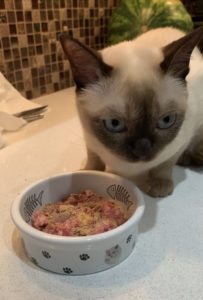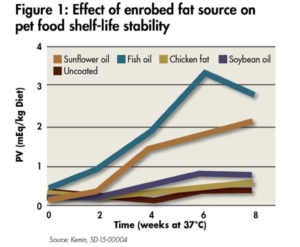Why Your Cat Doesn’t Like Leftovers & Solving Food Storage Issues

Have you ever noticed how your cat may love her food when it’s first opened but refuses to eat leftovers later? Or perhaps you’ve had to throw away half-empty bags of dry food because she turns her nose up and walks away? A cat’s nose knows when her food is fresh and when it’s no longer good to eat. This can be very frustrating and expensive for cat parents, so I’ve got some great tips to help you when it comes to expiration dates and food storage for pet food.
Oxidation–the bane of food storage
Listening to a Facebook Live with Dr. Karen Becker and Rodney Habib this week I learned some fascinating information about storing pet food. Turns out there’s a scientific reason behind why your cat may refuse to eat leftovers or food that’s been in the refrigerator, freezer or even the pantry for too long. It’s called oxidation. An article by Kemin about oxidation control in foods and beverages, describes the oxidation process as a chain reaction that occurs in the presence of oxygen, and this is what is responsible for the deterioration of the food. This process can lead to serious toxicity, especially when it comes to fats.
In a Kemin study, a lamb and rice-based pet food kibble was coated with chicken fat, soybean oil, sunflower oil or fish oil. Each fat sample contained the same level of antioxidant and was coated onto the kibble at 6% and then stored at 37˚C for eight weeks; peroxide values (PV) were measured every two weeks. The resulting data showed that the stability of the diets was directly related to the level of unsaturation in the topical fat.
Furthermore, Kemin did a study on dry kibble sprayed with different types of fats to see how stabile the shelf life of these diets were over time. It’s important to note that kibble is sprayed with fatty oils after they have been extruded/cooked because doing so beforehand destroys any antioxidant benefits. The results were quite eye opening: The fats on the kibble began to oxidize and become rancid at the two week mark. At 4-6 weeks the level of oxidation/rancidity was the highest. When put into perspective, this explains why many pets will eat the first half of the bag of kibble but may refuse the bottom half. Pets can tell when the food is too toxic to eat.
When does oxidation start?
The clock starts ticking the moment you open a food, whether it be dry, canned, fresh or frozen. Suppose you feed your cat wet, fresh or raw food; she eats most of the portion but doesn’t finish the bowl. So you leave it out for awhile thinking she’ll come back later to finish the rest. Have you noticed how the food starts to change its appearance after awhile? It looks much less appetizing, right? This is because air, and in some cases heat, cause bacteria to form due to the oxidation process. In most cases it’s best to pick up your cat’s food bowl after 30 minutes.
Food storage recommendations to maximize nutritional benefits and safety
So what can you do to minimize the oxidation process and keep your cat’s food fresh? Here are several suggestions that Dr. Becker and Rodney shared.
- Dry food: buy small bags and empty the kibble into glass or stainless steel containers. If storing the bag itself be sure to squeeze out as much air as possible and clip it tightly. Store in the freezer, and make sure you finish the food within 4 weeks. Write the OPENED date on the bag.
- Canned food: store leftovers in a glass or stainless steel storage container in the refrigerator, not in the can itself. Chemicals in the cans can begin to leech into the food once it’s opened. Use within a day.
- Fresh, homemade food: store in glass or stainless steel storage containers in the refrigerator for up to 4 days. If making a large amount freeze the rest. Use masking tape and write the date it was made on the container. Use within 3 months.
- Frozen/commercial food: Store as airtight as possible, and use within 3 months of opening. Write the OPENED date on the bag.
Finally, it’s also important to note that food stored in the freezer needs to be consumed within 3 months. Why? Studies have shown that there is significant nutrient loss and oxidation after the 3 month mark. This can have a profound impact on your cat’s health, including issues like fatal cardiomyopathy. Furthermore, the expiration date on the product only applies to an unopened product. Once the product is opened follow the recommended “use by” times mentioned above.
Want to learn more about feline nutrition? Check out this page!

